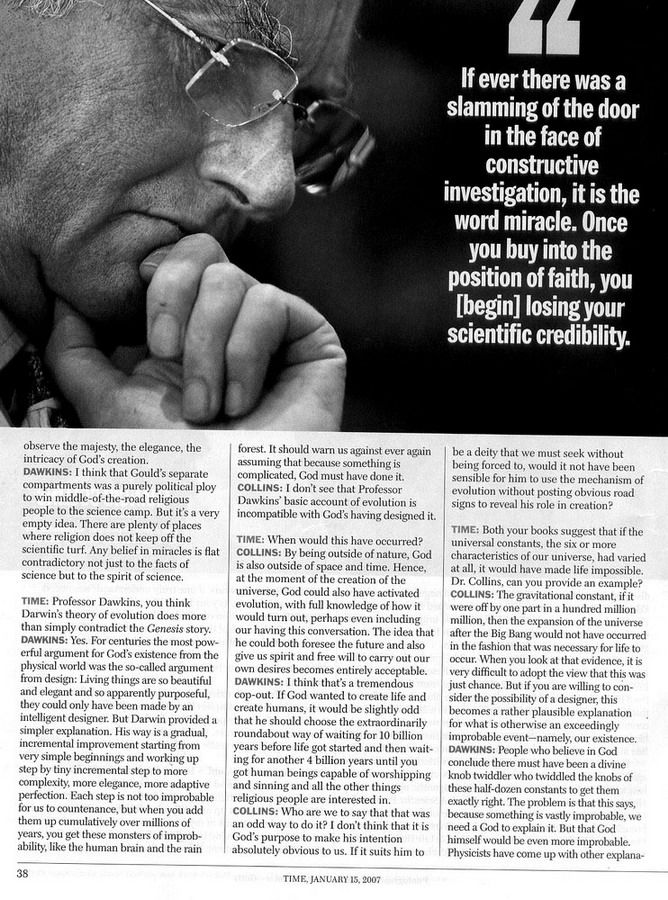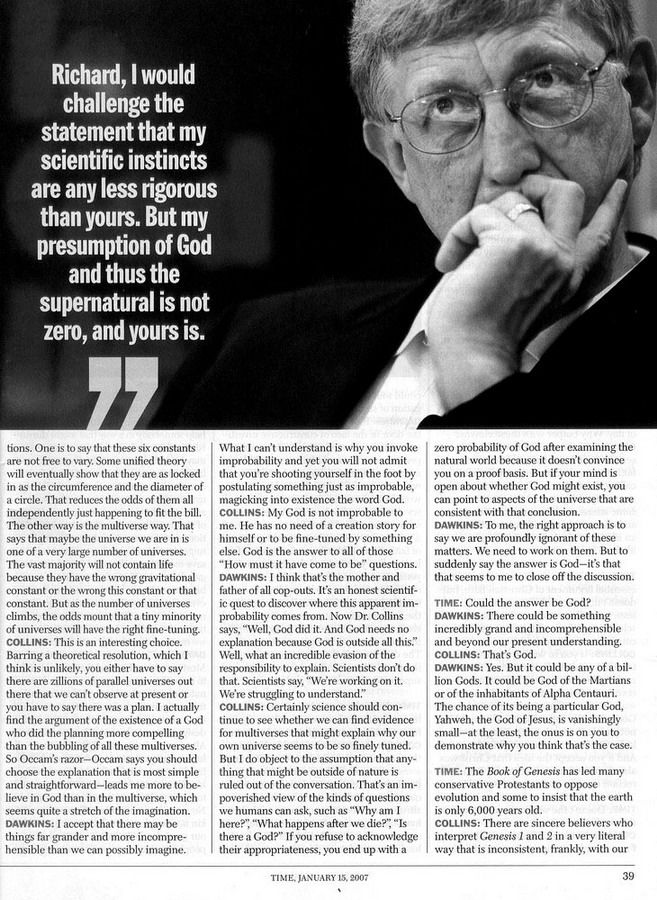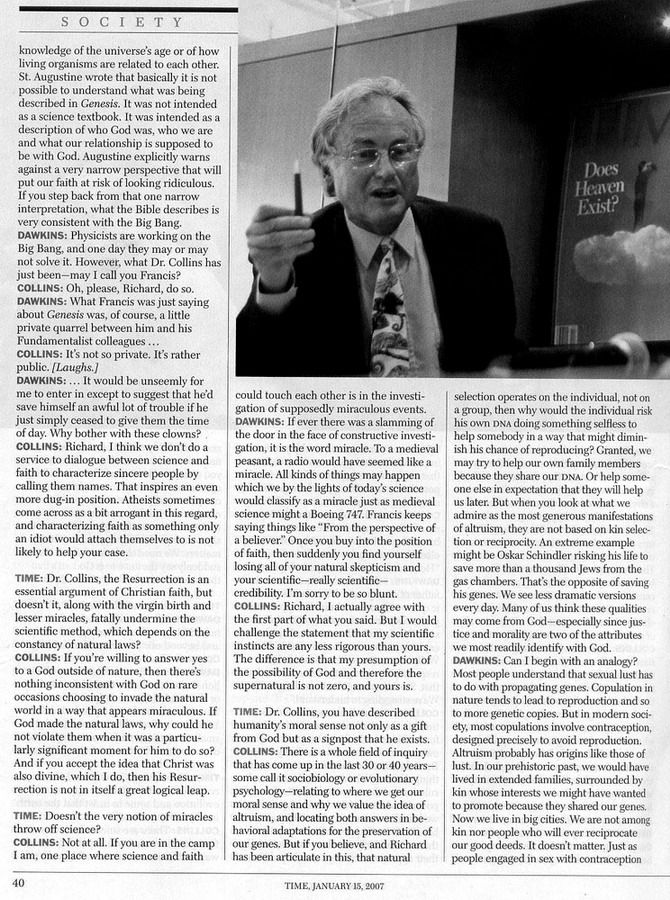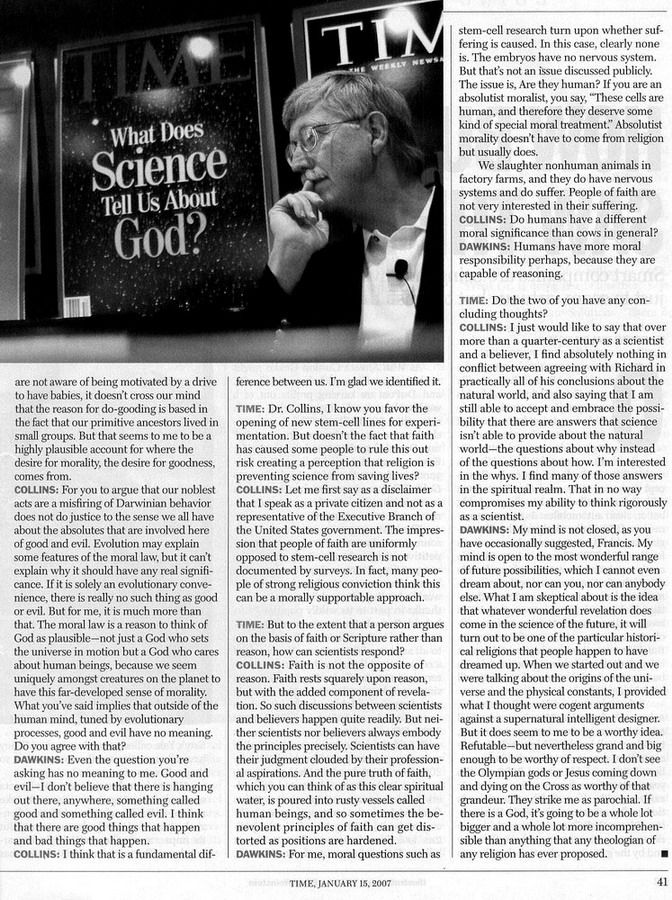This blog began with my interest in following the so called 'Scopes II' trials when I began collecting media reports, commentary, cartoons, defences & attacks published, here & there, by some of our leading scientists & religious leaders but it eventually came to hold much more than just the trials. I collected everything I thought interesting that science & Church had to say about morality, philosophy, etymology, politics plus poetry & even parody, like the clever & funny web-site called the Spaghetti Monster. Also a bit of history, historical quotes on the subject & transcriptions of interviews & debates with Richard Dawkins & the like. Unfortunately the trials weren’t as amusing as they might have been if the Intelligent Design camp had better arguments & more credible support but in the end I think I have compiled a fascinating & entertaining document. It covers both sides thoroughly &, I hope, with a minimum of repetition (& includes links to further reference). I have added my two cents here & there in red. It is chronological with dates noted. The 11 pages contain more than 100,000 words & vary between 13 & 130 KBs each |
pg 1 | pg 2 | pg 3 | pg 4 | pg 5 | pg 6 | pg 7 | pg 8 | pg 9 | pg 10 | pg 11




Published: May 24, 2007
NYTimes
PETERSBURG, Ky. — The entrance gates here are topped with metallic Stegosauruses. The grounds include a giant tyrannosaur standing amid the trees, and a stone-lined lobby sports varied sauropods. It could be like any other natural history museum, luring families with the promise of immense fossils and dinosaur adventures.
But step a little farther into the entrance hall, and you come upon a pastoral scene undreamt of by any natural history museum. Two prehistoric children play near a burbling waterfall, thoroughly at home in the natural world. Dinosaurs cavort nearby, their animatronic mechanisms turning them into alluring companions, their gaping mouths seeming not threatening, but almost welcoming, as an Apatosaurus munches on leaves a few yards away.
What is this, then? A reproduction of a childhood fantasy in which dinosaurs are friends of inquisitive youngsters? The kind of fantasy that doesn’t care that human beings and these prefossilized thunder-lizards are usually thought to have been separated by millions of years? No, this really is meant to be more like one of those literal dioramas of the traditional natural history museum, an imagining of a real habitat, with plant life and landscape reproduced in meticulous detail.
For here at the $27 million Creation Museum, which opens on May 28 (just a short drive from the Cincinnati-Northern Kentucky International Airport), this pastoral scene is a glimpse of the world just after the expulsion from the Garden of Eden, in which dinosaurs are still apparently as herbivorous as humans, and all are enjoying a little calm in the days after the fall.
It also serves as a vivid introduction to the sheer weirdness and daring of this museum created by the Answers in Genesis ministry that combines displays of extraordinary nautilus shell fossils and biblical tableaus, celebrations of natural wonders and allusions to human sin. Evolution gets its continual comeuppance, while biblical revelations are treated as gospel.
Outside the museum scientists may assert that the universe is billions of years old, that fossils are the remains of animals living hundreds of millions of years ago, and that life’s diversity is the result of evolution by natural selection. But inside the museum the Earth is barely 6,000 years old, dinosaurs were created on the sixth day, and Jesus is the savior who will one day repair the trauma of man’s fall.
It is a measure of the museum’s daring that dinosaurs and fossils — once considered major challenges to belief in the Bible’s creation story — are here so central, appearing not as tests of faith, as one religious authority once surmised, but as creatures no different from the giraffes and cats that still walk the earth. Fossils, the museum teaches, are no older than Noah’s flood; in fact dinosaurs were on the ark.
So dinosaur skeletons and brightly colored mineral crystals and images of the Grand Canyon are here, as are life-size dioramas showing paleontologists digging in mock earth, Moses and Paul teaching their doctrines, Martin Luther chastising the church to return to Scripture, Adam and Eve guiltily standing near skinned animals, covering their nakedness, and a supposedly full-size reproduction of a section of Noah’s ark.
There are 52 videos in the museum, one showing how the transformations wrought by the eruption of Mount St. Helens in 1980 reveal how plausible it is that the waters of Noah’s flood could have carved out the Grand Canyon within days. There is a special-effects theater complete with vibrating seats meant to evoke the flood, and a planetarium paying tribute to God’s glory while exploring the nature of galaxies.
Whether you are willing to grant the premises of this museum almost becomes irrelevant as you are drawn into its mixture of spectacle and narrative. Its 60,000 square feet of exhibits are often stunningly designed by Patrick Marsh, who, like the entire museum staff, declares adherence to the ministry’s views; he evidently also knows the lure of secular sensations, since he designed the “Jaws” and “King Kong” attractions at Universal Studios in Florida.
For the skeptic the wonder is at a strange universe shaped by elaborate arguments, strong convictions and intermittent invocations of scientific principle. For the believer, it seems, this museum provides a kind of relief: Finally the world is being
shown as it really is, without the distortions of secularism and natural selection.
Adam and Eve in the Land of the Dinosaurs
The Creation Museum actually stands the natural history museum on its head. Natural history museums developed out of the Enlightenment: encyclopedic collections of natural objects were made subject to ever more searching forms of inquiry and organization. The natural history museum gave order to the natural world, taming its seeming chaos with the principles of human reason. And Darwin’s theory — which gave life a compelling order in time as well as space — became central to its purpose. Put on display was the prehistory of civilization, seeming to allude not just to the evolution of species but also cultures (which is why “primitive” cultures were long part of its domain). The natural history museum is a hall of human origins.
The Creation Museum has a similar interest in dramatizing origins, but sees natural history as divine history. And now that many museums have also become temples to various American ethnic and sociological groups, why not a museum for the millions who believe that the Earth is less than 6,000 years old and was created in six days?
Mark Looy, a founder of Answers in Genesis with its president, Ken Ham, said the ministry expected perhaps 250,000 visitors during the museum’s first year. In preparation Mr. Ham for 13 years has been overseeing 350 seminars annually about the truths of Genesis, which have been drawing thousands of acolytes. The organization’s magazine has 50,000 subscribers. The museum also says that it has 9,000 charter members and international contributors who have left the institution free of debt.
But for a visitor steeped in the scientific world view, the impact of the museum is a disorienting mix of faith and reason, the exotic and the familiar. Nature here is not “red in tooth and claw,” as Tennyson asserted. In fact at first it seems almost as genteel as Eden’s dinosaurs. We learn that chameleons, for example, change colors not because that serves as a survival mechanism, but “to ‘talk’ to other chameleons, to show off their mood, and to adjust to heat and light.”
Meanwhile a remarkable fossil of a perch devouring a herring found in Wyoming offers “silent testimony to God’s worldwide judgment,” not because it shows a predator and prey, but because the two perished — somehow getting preserved in stone — during Noah’s flood. Nearly all fossils, the museum asserts, are relics of that divine retribution.
The heart of the museum is a series of catastrophes. The main one is the fall, with Adam and Eve eating of the tree of knowledge; after that tableau the viewer descends from the brightness of Eden into genuinely creepy cement hallways of urban slums. Photographs show the pain of war, childbirth, death — the wages of primal sin. Then come the biblical accounts of the fallen world, leading up to Noah’s ark and the flood, the source of all significant geological phenomena.
The other catastrophe, in the museum’s view, is of more recent vintage: the abandonment of the Bible by church figures who began to treat the story of creation as if it were merely metaphorical, and by Enlightenment philosophers, who chipped away at biblical authority. The ministry believes this is a slippery slope.
Start accepting evolution or an ancient Earth, and the result is like the giant wrecking ball, labeled “Millions of Years,” that is shown smashing the ground at the foundation of a church, the cracks reaching across the gallery to a model of a home in which videos demonstrate the imminence of moral dissolution. A teenager is shown sitting at a computer; he is, we are told, looking at pornography.
But given the museum’s unwavering insistence on belief in the literal truth of biblical accounts, it is strange that so much energy is put into demonstrating their scientific coherence with discussions of erosion or interstellar space. Are such justifications required to convince the skeptical or reassure the believer?
In the museum’s portrayal, creationists and secularists view the same facts, but come up with differing interpretations, perhaps the way Ptolemaic astronomers in the 16th century saw the Earth at the center of the universe, where Copernicans began to place the sun. But one problem is that scientific activity presumes that the material world is organized according to unchanging laws, while biblical fundamentalism presumes that those laws are themselves subject to disruption and miracle. Is not that a slippery slope as well, even affecting these analyses?
But for debates, a visitor goes elsewhere. The Creation Museum offers an alternate world that has its fascinations, even for a skeptic wary of the effect of so many unanswered assertions. He leaves feeling a bit like Adam emerging from Eden, all the world before him, freshly amazed at its strangeness and extravagant peculiarities.
Source: Washington Post
Date: 13 November 2004
Is the Capacity for Spirituality
Determined by Brain Chemistry?
Geneticist's Book 'The God Gene' Is Disputed by
Scientists, Embraced by Some Religious Leaders
By Bill Broadway
Dean H. Hamer has received much criticism for his new book, "The God Gene: How Faith is Hardwired Into Our Genes."
Evangelicals reject the idea that faith might be reduced to chemical reactions in the brain. Humanists refuse to accept that religion is inherent in people's makeup. And some scientists have criticized Hamer's methodology and what they believe is a futile effort to find empirical proof of religious experience.
But Hamer, a behavioural geneticist at the National Institutes of Health and the National Cancer Institute, stands by research he says shows that spirituality -- the feeling of transcendence -- is part of our nature. And he believes that a universal penchant for spiritual fulfilment explains the growing popularity of non-traditional religion in this country and the presence of hundreds of religions throughout the world.
"We think that all human beings have an innate capacity for spirituality and that that desire to reach out beyond oneself, which is at the heart of spirituality, is part of the human makeup," Hamer, 53, said in an interview at his Northwest Washington townhouse. "The research suggests some people have a bit more of that capacity than others, but it's present to some degree in everybody."
"The God Gene," published in September and featured in Time magazine's Oct. 25 cover story, is a sequel to "Living With Our Genes," a 1998 book in which Hamer examined the genetic basis of such behavioural traits as anxiety, thrill-seeking and homosexuality. Hamer said his previous research, most notably his work on anxiety, encouraged him to look into the genetic propensity for religious belief.
What he found was that the brain chemicals associated with anxiety and other emotions, including joy and sadness, appeared to be in play in the deep meditative states of Zen practitioners and the prayerful repose of Roman Catholic nuns -- not to mention the mystical trances brought on by users of peyote and other mind-altering drugs.
At least one gene, which goes by the name VMAT2, controls the flow to the brain of chemicals that play a key role in emotions and consciousness. This is the "God gene" of the book's title, and Hamer acknowledges that it's a misnomer. There probably are dozens or hundreds more genes, yet to be identified, involved in the universal propensity for transcendence, he said.
Furthermore, the scientific linkage of a gene with chemicals that affect happiness or sadness does not answer the question "Is there a God?" but rather "Why do we believe in God?""Our genes can predispose us to believe. But they don't tell us what to believe in," said Hamer, whose current research involves HIV/AIDS.
Critics in the scientific community argue that Hamer's conclusions are simplistic and speculative, relying too much on anecdotal evidence and too little on testing of the VMAT2 gene to determine other possible connections to behaviour. They also wonder whether his findings can be replicated, a necessity in scientific research.
"The field of behavioural genetics is littered with failed links between particular genes and personality traits," said Carl Zimmer, a science author who reviewed the book in last month's Scientific American.
Some religious leaders welcome the idea of a genetic basis for spirituality and say it validates long-held teachings.
"I wondered for a long time why [the concept of] a genetic implant hasn't been put in print or been part of a conversation in the broad theological community," said Bishop John B. Chane of the Episcopal Diocese of Washington. Chane associates Hamer's findings with the Apostle Paul's statement, "There are a variety of gifts but the same spirit."
Chane also welcomes the notion of genetic universality as a new, deeper way of promoting understanding among people of different faiths -- particularly Judaism, Christianity and Islam, all of which trace their beginnings to the same father, Abraham.
Others, such as Bishop Adam J. Richardson Jr. of the Washington area district of the African Methodist Episcopal Church, said that it's hard to quantify matters of the spirit and that attributing behaviour to one's genetic makeup "can be a frightful thing." By analogy, saying that people are predisposed to be spiritual also means that criminals are genetically wired to be criminals and have no hope of rehabilitation.
"Why not just put them in prison and throw away the key?" he asked.
Richardson said there's also the danger of people losing hope, of believing their genetic makeup limits their development and personal growth. "In my own system, we do have choice. We always have choice," the bishop said.
Hamer said his own religious development began in a Congregationalist church, which he abandoned when he became a scientist. But he discovered new spiritual meaning when he began researching this book -- through, in part, Zen meditative practices he learned at a Zen centre near Kyoto, Japan.
He likens spirituality to the capacity for language: Humans are genetically predisposed to have it, but the language people speak and the religion they practice are learned rather than inherited characteristics.
People are designed to communicate through language, but they speak English, French or Chinese because of the part of the world they grew up in. Similarly, genetic makeup urges people to believe in a Creator or find spiritual fulfilment, but culture, history and environment determine whether one is a Christian, Hindu, Jew, Buddhist or Muslim.
Although people can change or abandon that religious affiliation, they cannot rid themselves of the genetic propensity to be spiritual. But people can build on and develop that innate spirituality through meditation, prayer and creative arts such as music and painting. These practices can be done inside or outside organized religion, he said.
Hamer said he has received numerous comments from people who say that the dichotomy of spirituality and religion makes sense. "I always knew this, that I was inclined to be spiritual, even though I've always had a problem with religion," they tell him.
"I see more and more people doing things like yoga," Hamer said. "They do it initially because they want to get more flexible and look good and feel great. Then they find that once they spend some time sitting on a mat, doing nothing but concentrating on their body and clearing their mind of everything else, they say, 'That feels kind of good.' "
Such feelings can lead to an intuitive sense of God's presence, Hamer said. "We do not know God; we feel Him."
Organized religion can become so codified, so caught up with learned rituals, that the focus on spirituality gets lost, Hamer said. The resurgence of Pentecostalism and other emotion-based religions is one sign of the staying power of inherited spirituality, he said.
Megachurches, too, are part of this phenomenon and have widespread appeal because of the emotional aspects of worship, he said. "They have lots of music, video screens, the whole multimedia thing going on," he said. "They're tapping into that [innate spirituality]. It's fun and allows people to get into that spiritual frame of mind."
Hamer said more research has to be done to determine whether there is a genetic basis for other religion-related phenomena, including the existence of archetypes, the similarity of creation stories in various religions and the common characteristics of fundamentalism in Christianity, Judaism and Islam.
Also left hanging is why women score much higher than men on transcendence tests.
"I'm not completely sure about that," Hamer said. "I just know that it's true. Women are more attuned to their emotional connections, and that's at the heart of spirituality."
see page 2- brain chemistry (This is your brain on God)
pg 1 | pg 2 | pg 3 | pg 4 | pg 5 | pg 6 | pg 7 | pg 8 | pg 9 | pg 10 | pg 11